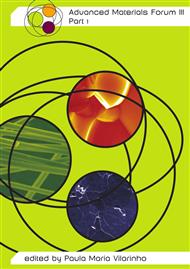[1]
Loven, A.W., Chem. Eng. Progr., 69, 56 (1973).
Google Scholar
[2]
Moreno, C., Rivera, J., Joly, J.P., López, M.V., Ferro, M.A., and Carrasco, F., Carbon, 33, 1417 (1995).
Google Scholar
[3]
San Miguel, G., Lambert, S.D., and Graham, N.J.D., Appl. Catalusis B: Environmental, 40, 185 (2003).
Google Scholar
[4]
San Miguel, G., Lambert, S.D., and Graham, N.J.D., Wat. Res., 35, 2740 (2001).
Google Scholar
[5]
Shweiger, T.A.J., and Douglas LeVan, M., Ind . Eng. Chem. Res., 32, 2418 (1993).
Google Scholar
[6]
Salvador, F, and Sánchez-Jiménez, C., Carbon, 34, 511 (1996).
Google Scholar
[7]
Salvador, F, and Sánchez-Jiménez, C., Carbon, 37, 577 (1999).
Google Scholar
[8]
Ehrhardt, H.M., and Rehm, H.J., Appl. Microbiol. Biotechnol., 30, 312 (1989).
Google Scholar
[9]
Voice, T.C., Pack, D., Zhao, X., Shi, J., and Hickey, R.F., Wat. Res., 26, 1389 (1992).
Google Scholar
[10]
Matatov-Meytal, Y.I., and Sheintuch, M., Catalysis Today., 53, 73 (1999).
Google Scholar
[11]
Mishra, V.S., Mahajani, V.V., and Joshi, J.B., Ind . Eng. Chem. Res., 34, 2 (1995).
Google Scholar
[12]
Narbaitz, R.M., and Cen, J., Wat. Res., 28(8), 1771 (1994).
Google Scholar
[13]
Comninellis, C., and Nerine, A., J. Appl. Electrochem., 25(1), 23 (1995).
Google Scholar
[14]
De Philippi, R.P., Krukonis, V.J. and Robey, R.J., EPA, (1980).
Google Scholar
[15]
Chihara, K., Oomori, K., and Mochizuki, Y., Wat. Sci. Tech., 35, 261 (1997).
Google Scholar
[16]
F. Salvador, C. Sánchez, Spain Patent 2127113; EU Patent 818240; USA Patent 5. 998. 324.
Google Scholar
[17]
Moreno, C., Rivera, J., López, M.V., and Carrasco, F., Carbon, 33, 845 (1995).
Google Scholar
[18]
Leng, C-C., and Pinto, N.G., Carbon, 35, 1375 (1997).
Google Scholar
[19]
Franz, M., Arafaf, M.A., Pinto, N.G. Carbon. 38, 1807, (2000).
Google Scholar
[20]
Moreno-Castilla, C., Carbon, 42, 83 (2004). 0 0. 4 0. 8 1. 2 1. 6 2 1. 08 1. 10 1. 12 1. 14 1. 16 103 1/T(K -1) lnkexp/s-1.
Google Scholar
[21]
Modell, M., de Filippi, R.P., and Krukonis V.J., Ann Arbor Science, vol. I, 447 (1980).
Google Scholar
[22]
Kander, R.G., Paulaitis, M.E., In Chemical Engineering and Supercritical Conditions; Penninger, J.M.L., Gray, R.D., Davidson, P., Eds.; Ann Arbor Science, 461 (1983).
Google Scholar
[23]
Chung-Sung T., and Din-Chung, L., Ind . Eng. Chem. Res., 28, 1222 (1989).
Google Scholar


